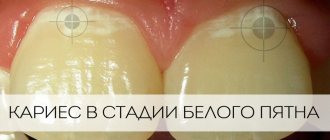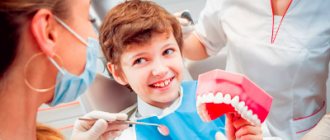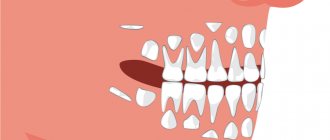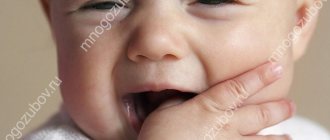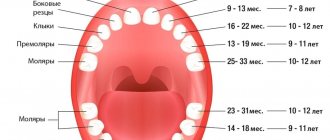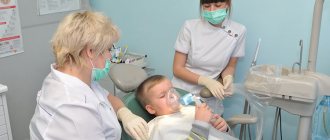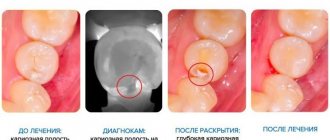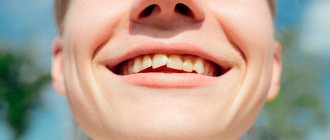- Treatment of caries and pulpitis of milk teeth
- Treatment of caries and pulpitis for children and adolescents under 16 years of age
- Children's prevention and hygiene
- Tooth extraction for children
- Anesthesia for children
If we talk about tooth extraction in children, then first of all we will talk about the removal of milk teeth for dental reasons and during the period of physiological change of teeth to permanent ones.
Permanent teeth have to be removed in children for the same reasons as in adults, and you can read about this in our article on tooth extraction.
How does baby teeth fall out?
The replacement of baby teeth with permanent ones is a physiological process. By the age of 3, a child grows 20 milk teeth in his mouth, which differ in structure from permanent teeth. They have thinner enamel and walls, and more branched roots. Then, gradually, the roots of baby teeth begin to dissolve. At the age of 5-6 years, baby teeth begin to loosen and fall out in the order in which they appeared, and in their place permanent teeth grow from the rudiments. The period of formation of a permanent dentition lasts up to 13-14 years and the appearance of 7 teeth - the second molars - ends. Healthy baby teeth and natural, timely replacement of teeth guarantee the child healthy teeth in his permanent dentition. Therefore, it is best if baby teeth fall out on their own and do not require additional doctor intervention, but this does not always happen.
A few words about caries prevention
The appearance of caries in babies can be prevented if you pay close attention to the child’s oral care and nutrition.
- It is necessary to develop the correct diet for the baby: up to 3-4 years of age, it is recommended to limit the consumption of sweets as much as possible; it is carbohydrates that provoke the development of caries in children. You should include as much dairy products, herbs, fruits, vegetables, and fish in your daily meals.
- At an early age, it is worth teaching your child to strictly adhere to a diet. You shouldn’t “follow” your beloved baby’s desire to snack on cookies in the middle of the night or drink sweet juice after brushing your teeth in the evening.
- Your baby should be taught to brush his teeth from the moment his first tooth appears. From the age of 1.5 years you can use a brush, and at an early age you can wipe the oral cavity of the crumbs with gauze swabs and special napkins. Also, on the recommendation of the dentist, you can treat the oral cavity with special anti-caries gels. For these purposes, “ASEPTA baby” wet wipes are perfect for cleaning the baby’s mouth, which will give the baby freshness, prevent the spread of bacteria and reduce discomfort during teething.
- It is also important for parents to follow the rules of hygiene - you should not lick your child’s spoon or pacifier, or eat from the same plate with him, because cariogenic bacteria from adults can spread to them.
Now you understand how important it is to cure caries of baby teeth at the first stage of development. Keep an eye on your baby’s health, and the problem of the consequences of removing baby teeth will be unfamiliar to you.
Is it possible to remove a baby tooth at home?
The human body is programmed to independently change teeth without complications. If the child does not have dental or general diseases, then the natural loss of a baby tooth is the most desirable scenario. You don't need to do anything to do this. Just when a child’s tooth is loose, pay extra attention to hygiene, because brushing a child’s loose teeth on their own is painful. Make sure that the child does not touch the tooth with his hands - it can cause an infection.
How to help a baby tooth fall out on its own?
The simplest and most effective way is to give your child something hard to chew on, such as an apple. It is better to refuse threads and other fancy devices.
If you decide to help the process a little and remove the interfering tooth yourself, clamp it with a sterile napkin, try to turn it a little around its axis and remove it. Do not “twist” the tooth with force or put pressure on it, so as not to damage the bone and soft tissue. After removal, have your child bite on a sterile cotton swab for 10-15 minutes. There is no need to rinse your mouth after removal; do not feed your child solid food or hot foods for several days.
If you suspect that the tooth has not been completely removed, or the child complains that there is a sharp edge in the hole that “scratches” - contact your dentist as soon as possible.
When should a pediatric dentist remove a baby tooth?
There are cases when a baby tooth needs to be removed without waiting for natural loss.
If the tooth is not loose, it CANNOT be removed at home; this can ONLY be done by a pediatric dentist. Temporary teeth have long roots, underneath them there are the rudiments of permanent teeth that can be damaged, and baby teeth themselves are fragile and easy to break. Tooth extraction is a mini-operation, for which you need to contact a specialist.
In what cases does a baby tooth need to be removed?
- The tooth is damaged by 50% or more by caries and cannot be restored.
- Serious complications of caries have led to the fact that the tooth is a source of infection that cannot be cured - periodontitis, periostitis, phlegmon.
- A fistula has formed on the gum next to the tooth.
- A cyst was found on the root of a baby tooth.
- The tooth is injured (severely chipped, twisted by a blow, broken and scratches the mucous membrane)
- The tooth wobbles for a long time, but holds tightly and cannot fall out on its own, which prevents the child from eating.
- The loose tooth became infected and inflammation began.
- A permanent tooth has already erupted next to the milk one, but the milk tooth is not going to fall out.
- If, according to the timing, the baby tooth should have fallen out a long time ago and a permanent one should have grown in its place, but nothing happens. This indicates a delay in root resorption. In order to understand how to proceed, an X-ray diagnosis of the presence of a permanent tooth germ is needed. If there is a germ, then it is better to remove the baby tooth to cause the growth of a permanent one.
- Sometimes a tooth needs to be removed for orthodontic reasons.
What anesthesia is used to remove baby teeth in children?
If we are talking about removing a baby tooth that is already loose, without complications and signs of inflammation, then such removal does not require pain relief.
If a problematic baby tooth is removed or it sits firmly in the jaw, then local anesthesia is used for children, sometimes with sedation.
Tooth extraction under anesthesia (general anesthesia) is possible in special clinics where a team of anesthesiologists works. From a medical point of view, in most cases there is no need to remove baby teeth under anesthesia. This is usually due to the fear of the child and his parents. The use of anesthesia is justified only in cases of serious mental disorders or complex illnesses, because it has more dangers than benefits .
Removal without pain
In pediatric dentistry, it is very important to ensure the child’s comfort during the tooth extraction procedure. This applies to all stages of treatment. To prevent the baby from being afraid, double anesthesia is used:
- Anesthetic gel. It is necessary to reduce the sensitivity of the gums and prepare for further anesthesia.
- Injection anesthesia. After the gel begins to take effect, the nurse will inject an anesthetic into the gum. Thanks to the action of the gel, the child does not feel pain from the injection.
Many drugs for local anesthesia, which are used to anesthetize tooth extraction, are strong allergens. In order to exclude the possibility of an allergy, the child is given a skin test.
What are the dangers of early removal of baby teeth?
If a temporary tooth is forced to be removed before its natural loss by more than a year, then we are talking about early removal. This situation provokes malocclusion and improper development of the entire dental system, including delayed jaw growth.
Neighboring teeth strive to take the place of their distant counterpart, and all of them are displaced.
adjacent teeth and their roots, antagonist teeth also move into the resulting free space. As a result, permanent teeth can erupt chaotically and even outside the dentition. In the future, such a problem will require long-term orthodontic treatment.
In addition, earlier removal of chewing teeth leads to a redistribution of the load on the front teeth, which, in turn, begin to collapse.
Therefore, it is so important to strive to keep all baby teeth in their places for as long as possible, preferably until the time of their natural replacement.
Alternatives to anesthesia
If the main reason for considering the possibility of using anesthesia during tooth extraction is the child’s fear, then as an alternative, a simpler way to solve the problem can be offered. We are talking about the use of a method such as oxygen-nitrogen sedation, which has nothing to do with anesthesia. The child simply inhales a mixture of sedative gases through a mask and psychologically relaxes. Thus, after the teeth are removed, he is left with only positive emotions. At the same time, during sedation, the baby does not sleep, is conscious, breathes and speaks independently. In parallel with sedation, local anesthesia is used to eliminate pain. However, it is not recommended to use this method if the child does not have nasal breathing or during periods of exacerbation of chronic diseases.
What to do if a child has a baby tooth removed early?
If trouble happens and the child has one or more milk teeth removed ahead of schedule, it is necessary to take measures to restore the dentition and preserve the space after the extracted teeth.
For this purpose, special dentures are used - removable plates with artificial teeth or special orthodontic structures are installed. In any case, after early removal, you must take the child for a consultation with an orthodontist - he will suggest the right solution. For more information about the treatment of malocclusion problems in children, read: “Children’s orthodontics - correcting the bite in children.”
Treatment at the SHiFA clinic
The Shifa clinic employs experienced pediatric dentists, who in their activities are guided by the principle “noli nocere” - do no harm!
Sparing no time and effort, specialists fight for every tooth, trying to extend its service life. They convince parents and children of the need to preserve the integrity of the dentition. The skill and painstaking work of professionals brings excellent results - painless and high-quality treatment of primary occlusion becomes a guarantee of the harmonious development of the maxillofacial area.
When should a baby tooth not be removed?
There are situations when it is IMPOSSIBLE to remove a baby tooth, so as not to aggravate the child’s condition or provoke serious complications.
- If a child suffers from an acute infectious disease, then removal should be postponed until complete recovery.
- If there is an acute inflammatory process in the oral cavity - stomatitis, gingivitis, candidiasis (thrush), then removal is carried out after the acute stage of the disease subsides.
- If the tooth is located in the area of any tumor, removal is carried out together with the tumor and in the hospital.
- Teeth removal is carried out with caution in small patients suffering from diseases of the central nervous system, heart, kidneys, and blood.
How to go to the dentist, remove a baby tooth and not scare your baby?
It is recommended that a child’s baby teeth be removed by pediatric dentists: it will be painless, safe and timely. For everything to go smoothly, a visit to the dentist should be associated with something pleasant and calm. Modern dentistry has a friendly atmosphere, new painkillers have appeared, and instruments (especially in children's offices) do not inspire fear.
Finally, our advice: don’t worry and don’t let your child worry. The calmer you are about going to the dentist, the calmer your baby will behave. Stay nearby in the dentist's office, because parental support is extremely important to him.
What to do after a child’s tooth extraction?
- Make sure that the child spits out the tampon that was placed after removal after 15-20 minutes.
- After removal, a blood clot should remain in the hole, which protects it from inflammation. There is no need to clean the hole from blood, rinse the mouth, the child should not touch the removal site with hands or objects.
- If the child has been given anesthesia, explain to the child that he should not bite on the numb side until the feeling of cold and pins and needles goes away.
- Feed your baby only warm, soft food for several days.
- Maintain good hygiene; brushing your teeth is not only possible, but also necessary, with a soft toothbrush, carefully avoiding the extraction site.
- If the tooth extraction was difficult, then try to limit the child’s physical activity so as not to provoke bleeding.
How to properly prepare a child for tooth extraction in pediatric dentistry?
- A brave child is one who is familiar with the place and situation, so parents need to try to ensure that the first visit to the dental clinic is not associated with treatment, much less tooth extraction and pain. Go with your child to the dental clinic for preventive examinations, children's parties, which we regularly hold, take your child with you when you go to have your teeth treated.
- A good, cozy clinic is not a dream today, but an accessible reality. Go to the clinic yourself without your child, meet the doctor. The atmosphere should be calm, the space should be thought out for small patients. And, of course, no screaming or crying behind office doors.
- Never frighten your child with the dentist or doctors in general, and do not be afraid of them yourself - children subtly sense the mood of their parents.
- Ask your doctor whether it is better to leave your child alone or be present during the procedure. NEVER leave your child alone at the dentist's office if this is their first appointment with the dentist.
- Do not shame your child in the dentist's chair, do not blackmail him with a gift or threaten him with punishment. Introduce him to the doctor and help establish contact between them, using the child’s natural curiosity - he should be interested, not scared.
How is tooth extraction performed for children under general anesthesia?
Tooth extraction for children under general anesthesia can be divided into 4 stages.
- Preparation for the procedure
Before tooth extraction under anesthesia, the child must visit a pediatrician to undergo a comprehensive examination of the body, followed by all necessary tests and an ECG. The baby should stop eating 6 hours before the procedure itself, and 4 hours before the start of the procedure, stop drinking liquids. - Anesthesia
The child is put to sleep using an inhalational anesthetic administered through a mask or an intravenous injection. At the same time, the anesthesiologist monitors his condition at all stages of the surgical operation. - Tooth extraction
The procedure itself for removing teeth for children under general anesthesia consists of the following manipulations.
- The doctor places forceps on the crown of the tooth and moves them along its perimeter.
- He then places the forceps on the tooth and dislocates it.
- Next, the doctor removes the tooth from the hole and checks whether all the roots have been removed.
- The tooth socket is pressed with a sterile gauze swab.
- If necessary, X-ray diagnostics are performed.
- Rehabilitation
After waking up, it is better for the child to stay in the clinic for several hours for medical monitoring of his condition. After anesthesia, your baby should be fed light foods, such as yogurt or broth. Do not give your child any medications unless they have been prescribed by your doctor. If you strictly follow all the recommendations of specialists, the rehabilitation period should pass safely and without side effects.
Traditionally, clinics use two main types of anesthesia: inhalation (mask) and intravenous. During inhalation anesthesia, substances that induce sleep enter the child’s body through the respiratory tract. As a rule, these are halogen-containing gases: Sevoran, Foran, etc. This method is considered the most comfortable for a small patient, because the child quickly falls asleep and does not experience discomfort when waking up. During intravenous anesthesia, sleep medications (propofol or benzodiazepines) are released into the bloodstream by injection.
